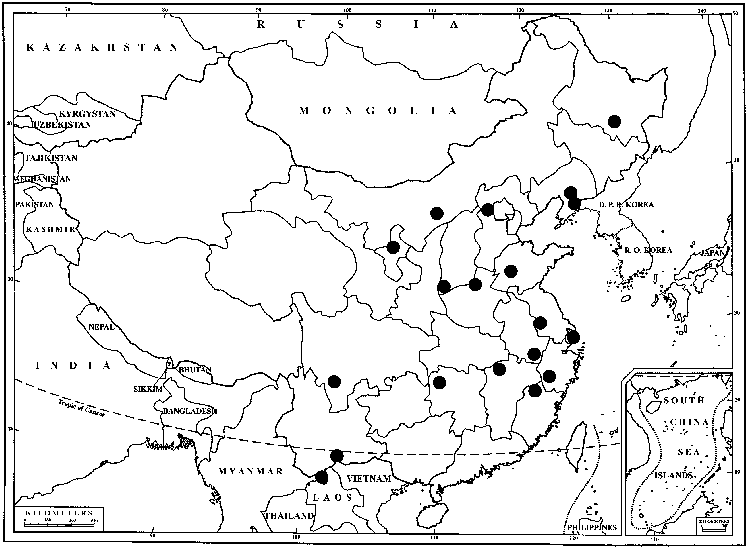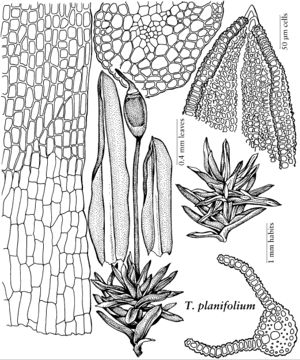Difference between revisions of "Trichostomum planifolium"
Bull. Buffalo Soc. Nat. Sci. 32: 92. 1993,.
FNA>Volume Importer |
FNA>Volume Importer |
||
| Line 13: | Line 13: | ||
|name=Trichostomum perligulatum | |name=Trichostomum perligulatum | ||
|authority=(H. A. Crum) R. H. Zander | |authority=(H. A. Crum) R. H. Zander | ||
| − | }}{{Treatment/ID/Synonym | + | }} {{Treatment/ID/Synonym |
|name=Weissia perligulata | |name=Weissia perligulata | ||
|authority=H. A. Crum | |authority=H. A. Crum | ||
| − | }}{{Treatment/ID/Synonym | + | }} {{Treatment/ID/Synonym |
|name=Weissia sweetii | |name=Weissia sweetii | ||
|authority=E. B. Bartram | |authority=E. B. Bartram | ||
| Line 33: | Line 33: | ||
|elevation=moderate elevations | |elevation=moderate elevations | ||
|distribution=Calif.;Colo.;Nev.;N.Mex.;Mexico;e Asia (China;Japan). | |distribution=Calif.;Colo.;Nev.;N.Mex.;Mexico;e Asia (China;Japan). | ||
| − | |discussion=<p>Trichostomum planifolium was synonymized with T. crispulum by A. Stoneburner (1985) and Stoneburner and R. Wyatt (1985), but is retained here because it is monoicous. The leaf margins are sometimes inflexed distally, as in Weissia, and it was synonymized with Weissia perligulata by L. R. Stark (1996), the type of which has weakly inflexed or laxly involute distal leaf margins. The costa of T. planifolium and the similar T. brachydontium is quite thick and protrudes strongly abaxially. The gametophyte of Trichostomum planifolium is essentially that of T. brachydontium. It differs from Weissia inoperculata in having a slightly shorter apiculus, in addition to the stegocarpic capsule. Some plants of the type of W. perligulata (= T. planifolium) have comparatively very wide leaves with costa ending below the broadly rounded apex, yet other plants have leaves with costae that are percurrent or shortly excurrent from an obtuse or rounded acute apex, and in all leaves the papillae are large and short-spiculose, though not as salient as those of specimens assigned to W. andersoniana (= W. ligulifolia); S. Flowers (1973) suspected that W. ligulifolia and W. perligulata are synonymous, but found sexual differences between them on the basis of a few specimens; here the former is distinguished by the strongly involute distal laminal margins and distal lamina ca. 12–18 cells across on one side of the costa just above mid leaf versus margins plane or weakly incurved to laxly inflexed, and lateral lamina 25–30 cells across for T. planifolium.</p> | + | |discussion=<p><i>Trichostomum planifolium</i> was synonymized with <i>T. crispulum</i> by A. Stoneburner (1985) and Stoneburner and R. Wyatt (1985), but is retained here because it is monoicous. The leaf margins are sometimes inflexed distally, as in <i>Weissia</i>, and it was synonymized with <i>Weissia</i> perligulata by L. R. Stark (1996), the type of which has weakly inflexed or laxly involute distal leaf margins. The costa of <i>T. planifolium</i> and the similar <i>T. brachydontium</i> is quite thick and protrudes strongly abaxially. The gametophyte of <i>Trichostomum planifolium</i> is essentially that of <i>T. brachydontium</i>. It differs from <i>Weissia inoperculata</i> in having a slightly shorter apiculus, in addition to the stegocarpic capsule. Some plants of the type of W. perligulata (= <i>T. planifolium</i>) have comparatively very wide leaves with costa ending below the broadly rounded apex, yet other plants have leaves with costae that are percurrent or shortly excurrent from an obtuse or rounded acute apex, and in all leaves the papillae are large and short-spiculose, though not as salient as those of specimens assigned to W. andersoniana (= <i>W. ligulifolia</i>); S. Flowers (1973) suspected that <i>W. ligulifolia</i> and W. perligulata are synonymous, but found sexual differences between them on the basis of a few specimens; here the former is distinguished by the strongly involute distal laminal margins and distal lamina ca. 12–18 cells across on one side of the costa just above mid leaf versus margins plane or weakly incurved to laxly inflexed, and lateral lamina 25–30 cells across for <i>T. planifolium</i>.</p> |
|tables= | |tables= | ||
|references= | |references= | ||
| Line 56: | Line 56: | ||
|publication year= | |publication year= | ||
|special status= | |special status= | ||
| − | |source xml=https://jpend@bitbucket.org/aafc-mbb/fna-data-curation.git/src/ | + | |source xml=https://jpend@bitbucket.org/aafc-mbb/fna-data-curation.git/src/8f726806613d60c220dc4493de13607dd3150896/coarse_grained_fna_xml/V27/V27_708.xml |
|subfamily=Pottiaceae subfam. Trichostomoideae | |subfamily=Pottiaceae subfam. Trichostomoideae | ||
|genus=Trichostomum | |genus=Trichostomum | ||
Revision as of 17:56, 18 September 2019
Stem rounded-pentagonal in section. Leaves flattened, ovate to elliptical, distal margins plane or weakly erect or rarely broadly involute, entire, not bordered; apex rounded or rounded-acute, plane to weakly concave, keeled or cucullate; basal cells evenly differentiated across leaf base or as a U, only weakly running up margins if at all, not distinctly enlarged submarginally; distal laminal cells pluripapillose with low papillae; mucro short-conic, of 3–4 cells. Sexual condition autoicous. Peristome teeth absent to short-lanceolate.
Habitat: Soil, margins of boulders, rock crevices
Elevation: moderate elevations
Distribution

Calif., Colo., Nev., N.Mex., Mexico, e Asia (China, Japan).
Discussion
Trichostomum planifolium was synonymized with T. crispulum by A. Stoneburner (1985) and Stoneburner and R. Wyatt (1985), but is retained here because it is monoicous. The leaf margins are sometimes inflexed distally, as in Weissia, and it was synonymized with Weissia perligulata by L. R. Stark (1996), the type of which has weakly inflexed or laxly involute distal leaf margins. The costa of T. planifolium and the similar T. brachydontium is quite thick and protrudes strongly abaxially. The gametophyte of Trichostomum planifolium is essentially that of T. brachydontium. It differs from Weissia inoperculata in having a slightly shorter apiculus, in addition to the stegocarpic capsule. Some plants of the type of W. perligulata (= T. planifolium) have comparatively very wide leaves with costa ending below the broadly rounded apex, yet other plants have leaves with costae that are percurrent or shortly excurrent from an obtuse or rounded acute apex, and in all leaves the papillae are large and short-spiculose, though not as salient as those of specimens assigned to W. andersoniana (= W. ligulifolia); S. Flowers (1973) suspected that W. ligulifolia and W. perligulata are synonymous, but found sexual differences between them on the basis of a few specimens; here the former is distinguished by the strongly involute distal laminal margins and distal lamina ca. 12–18 cells across on one side of the costa just above mid leaf versus margins plane or weakly incurved to laxly inflexed, and lateral lamina 25–30 cells across for T. planifolium.
Selected References
None.
